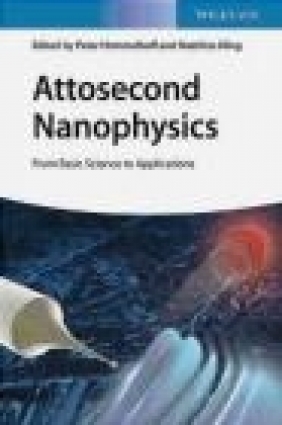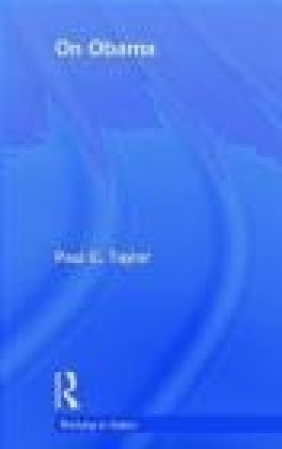Attosecond Nanophysics
Matthias Kling, Peter Hommelhoff
Attosecond Nanophysics
Matthias Kling, Peter Hommelhoff
- Producent: VCH
- Rok produkcji: 2015
- ISBN: 9783527411719
- Ilość stron: 392
- Oprawa: Twarda
Niedostępna
Opis: Attosecond Nanophysics - Matthias Kling, Peter Hommelhoff
The first broad and in-depth overview of current research in attosecond nanophysics, covering the field of active plasmonics via attosecond science in metals and dielectrics to novel imaging techniques with the highest spatial and temporal resolution. The authors are pioneers in the field and present here new developments and potential novel applications for ultra-fast data communication and processing, discussing the investigation of the natural timescale of electron dynamics in nanoscale solid state systems. Both an introduction for starting graduate students, as well as a look at the current state of the art in this hot and emerging field.
List of Contributors XI
Preface XVII
1 Introduction 1 Matthias F. Kling, Brady C. Steffl, and Peter Hommelhoff
1.1 Attosecond Tools 1
1.1.1 Strong Field Control Using Laser Pulses withWell-Defined Waveforms 1
1.1.2 Attosecond Light Pulses: Tracing Electron Dynamics 3
1.2 Solids in Strong Fields 4
1.3 Attosecond Physics in Isolated Nanosystems 4
1.4 Attosecond Physics on Nanostructured Surfaces 6
1.5 Perspectives 7
References 8
2 Nano-Antennae Assisted Emission of Extreme Ultraviolet Radiation 11 Nils Pfullmann, Monika Noack, Carsten Reinhardt,Milutin Kovacev, and Uwe Morgner
2.1 Introduction and Motivation 11
2.2 Experimental Idea 12
2.3 High-Order Harmonic Generation 14
2.3.1 Semi-Classical Model 15
2.3.2 Macroscopic Effects/Phase-Matching 16
2.3.3 Phase-Matching in the Case of Optical Antennas 18
2.3.4 Field Inhomogeneities 19
2.4 Plasmonics in Intense Laser Fields 20
2.5 Experiments 23
2.5.1 Historical Overview 23
2.5.2 Own Experiments 24
2.5.2.1 Experimental Set-Up 24
2.5.2.2 Experimental Results 26
2.5.2.3 Gas Density 28
2.5.2.4 Spectra 29
2.6 Conclusion and Outlook 31
References 33
3 Ultrafast, Strong-Field Plasmonic Phenomena 39 Peter Dombi and Abdulhakem Y. Elezzabi
3.1 Introduction 39
3.2 Ultrafast Photoemission and Electron Acceleration in Surface Plasmon Fields 43
3.2.1 Photoemission Mechanisms 43
3.2.1.1 Linear Photoemission 43
3.2.1.2 Nonlinear Photoemission and Photocurrents 43
3.2.1.3 Distinction of the Photoemission Regimes 44
3.2.1.4 Multiphoton-Induced Photoemission and Photocurrents 44
3.2.1.5 Above-Threshold Photoemission 46
3.2.1.6 Tunneling Photoemission and Currents 46
3.2.2 Particle Acceleration in Evanescent Surface Plasmon Fields 47
3.3 Research on Surface Plasmon-Enhanced Photoemission and Electron Acceleration 48
3.3.1 Photocurrent Enhancement 48
3.3.2 Strong-Field Photoemission in Plasmonic Fields 50
3.3.3 Electron Acceleration in Plasmonic Fields 51
3.3.4 Modeling and Discussion 53
3.3.4.1 Modeling Tools 53
3.3.4.2 Electromagnetic Wave Dynamics of the Surface Plasmon Field 55
3.3.4.3 Electron Emission Channels and Currents Induced by the Plasmonic Fields 57
3.3.4.4 Particle Acceleration in the Evanescent Field 58
3.3.4.5 Model Results for High-Energy Electron Generation 60
3.3.5 Time-Resolved Studies of Ultrashort Surface Plasmon Wavepackets 62
3.3.5.1 Experiments 62
3.3.5.2 Autocorrelation ReconstructionWithout Fitting Parameters 64
3.3.6 The Carrier-Envelope Phase in Nanoplasmonic Electron Acceleration 66
3.3.7 Non-ponderomotive Effects and Quiver Motion Quenching in Nano-Localized Fields 69
3.3.8 Nanoplasmonic Photoemission from Metal Nanoparticles 75
3.4 Conclusions 79
Acknowledgments 81
References 81
4 Ultrafast Dynamics in Extended Systems 87 Ulf Saalmann and Jan-Michael Rost
4.1 Introduction Why Ultrafast Electron Dynamics in Extended Systems? 87
4.2 Multi-Photon Absorption in Extended Systems 89
4.2.1 General Evolution of an Extended System Exposed to an Intense Laser Pulse 89
4.2.2 A Unified Picture on Energy Absorption from Intense Light Fields 91
4.2.3 Hard and Soft Recollisions in Atomic Systems 93
4.2.4 Extended Systems and Optical Swingbys 94
4.2.5 Resonant Absorption by Electron Motion Out of Phase with the Light Field 97
4.3 Coulomb Complexes: A Simple Approach to Ultrafast Electron Dynamics in FEL-Irradiated Extended Systems 99
4.3.1 Photo-Activation 101
4.3.2 The Ionic Background Potential 102
4.3.3 Formation of the Electron Spectra 103
4.3.4 Scaling in the Dynamics of Coulomb Complexes 105
4.4 Nano-Plasma Transients on the Femtosecond Scale 106
4.4.1 Creating and Probing a Dense Non-equilibrium Nano-Plasma by Sub-femtosecond Pump-Probe Pulses 106
4.4.2 Ultrafast Collective Electron Dynamics in Composite Systems 111
4.5 Summary 115
Acknowledgments 115
References 116
5 LightWave Driven Electron Dynamics in Clusters 119 Charles Varin, Christian Peltz, Thomas Brabec, and Thomas Fennel
5.1 Introduction 119
5.2 Resolving Light-Matter Interactions on the Atomic-Scale 120
5.2.1 Theoretical Foundations of Classical Light-Matter Interaction 120
5.2.2 Molecular Dynamics 125
5.2.3 The Particle-in-Cell Method 125
5.2.4 The Microscopic Particle-in-Cell Method 126
5.3 Fundamentals of the Microscopic Particle-in-Cell Approach 127
5.3.1 Theoretical Background 127
5.3.2 Numerical Implementation 130
5.3.2.1 The Electromagnetic Solver 130
5.3.2.2 Gaussian-Shape Particles and Microscopic Force Correction 131
5.3.2.3 Linear Scaling with MicPIC 133
5.3.2.4 Typical Numerical Parameters 134
5.3.3 Link to Molecular Dynamics 134
5.3.4 Link to Continuum Models 135
5.4 Microscopic Analysis of Laser-Driven Nanoclusters 137
5.4.1 Nanoplasma Formation in a Small Rare-Gas Cluster 138
5.4.2 Cluster Dynamics in the Linear Response Regime 140
5.4.3 Linear Absorption and Scattering of Light 142
5.4.4 Competition of Bulk and Surface Effects with Radiation Damping in Resonant Clusters 144
5.4.5 Microscopic Analysis of Nonlinear Light Scattering 145
5.5 Conclusions 149
References 150
6 FromAttosecond Control of Electrons at Nano-Objects to Laser-Driven Electron Accelerators 155 Frederik Sussmann, Matthias F. Kling, and Peter Hommelhoff
6.1 Attosecond Control of Electrons at Nanoscale Metal Tips 155
6.1.1 Multi-Photon Ionization 156
6.1.1.1 Coherent Effects 157
6.1.1.2 Light Shifts 157
6.1.2 Sub-Cycle Dynamics 158
6.1.2.1 Recollision and Rescattering 158
6.1.2.2 CEP Effects and MatterWave Interference 160
6.1.2.3 Modeling of Strong-Field Physics at a Metal Tip Instructively 160
6.1.2.4 Modeling of Strong-Field Physics at a Metal Tip Microscopically 161
6.1.3 Optical Near-Field Sensor 162
6.1.4 A Sub-Laser-Cycle Duration Electron Source? 164
6.2 Experiments on Dielectric Nanospheres 165
6.2.1 Modifications by Collective Excitations/Space Charge 165
6.2.2 CEP-Dependent Photoemission from SiO2 Nanospheres 166
6.2.3 Theoretical Modeling of the Photoemission/Acceleration Process 169
6.3 The Influence of the Spatial Field Distribution on Photoelectron Spectra 171
6.3.1 Transition from Dipolar to Multipolar Response 172
6.3.1.1 Mie Solution for Nanospheres 172
6.3.2 Angular Resolved Photoemission from SiO2 Nanospheres 176
6.4 Time Resolved Pump-Probe Schemes 177
6.4.1 The Attosecond Streak Camera 177
6.4.2 Attosecond Streaking from Nanostructures 179
6.4.3 The Regimes of Near-Field Streaking 179
6.4.4 Simulated Streaking Spectrograms for Au Spheres 182
6.5 Electron Acceleration with Laser Light at Dielectric Nano-Gratings 185
6.5.1 Near-Field Mode Acceleration 186
6.5.2 Proof-of-Concept Data 189
6.5.3 Outlook on Future Acceleration Mechanisms 190
References 191
7 Theory of Solids in Strong Ultrashort Laser Fields 197 Vadym Apalkov and Mark I. Stockman
7.1 Interaction of Ultrafast Laser Pulse with Solids: Coherent and Incoherent Electron Dynamics 197
7.2 One Dimensional Tight Binding Model 200
7.2.1 Single-Band Approximation 201
7.2.1.1 Exact Solution 201
7.2.1.2 Wannier Stark Levels 202
7.2.2 Multi-Band Approximation 210
7.2.3 Description of Electron Dynamics in Terms of the Wannier Stark States 213
7.2.3.1 Wannier Stark States of Two-Band System 213
7.2.3.2 Adiabatic and Diabatic Electron Dynamics 217
7.2.4 Results of Numerical Calculations 221
7.2.4.1 Electron Dynamics and Breakdown of Dielectric 221
7.2.4.2 Enhancement of the Dielectric Response of a Solid in a Strong Laser Pulse 225
7.2.4.3 Electrical Current and Charge Transfer 227
7.3 3D Model of Electron Dynamics 229
References 232
8 Controlling and Tracking Electric Currents with Light 235 Agustin Schiffrin, Tim Paasch-Colberg, and Martin Schultze
8.1 Introduction 235
8.2 Electric Field Control of Currents: From the Vacuum Tube to the Transistor 235
8.3 Generating Electric Currents with Light: An Ultrabroad-Bandwidth Control Tool 239
8.4 Optical Field Control of Electric Current in Large Bandgap Materials 243
8.5 Attosecond Probing of the Strong-Field-Induced Changes of the Dielectric Electronic Properties 262
8.6 Detection of the Carrier-Envelope Phase Using Optical-Field-Induced Currents 271
8.7 Toward Ultrafast Photoactive Logic Circuits? 273
References 275
9 Ultrafast Nano-Focusing for Imaging and Spectroscopy with Electrons and Light 281 Christoph Lienau, Markus Raschke, and Claus Ropers
9.1 Introduction 281
9.2 Adiabatic Nanofocusing 282
9.2.1 Introduction 282
9.2.2 Results 286
9.2.2.1 Experimental Demonstration of Adiabatic Nanofocusing on a Tip 286
9.2.2.2 Nano-Spectroscopic Imaging 289
9.2.2.3 Femtosecond Optical Control 291
9.2.3 Quantum Coherent Control of a Single Emitter 295
9.3 Nanometer-Sized Localized Electron Sources 297
9.3.1 Introduction 297
9.3.2 Processes in Localized Photoemission at Metal Nanotips 299
9.3.3 Near-Field Imaging Based on Localized Multiphoton Photoemission 301
9.3.4 Transition to the Strong-Field Regime 302
9.3.5 Localization Effects in the Strong-Field Regime 303
9.3.6 Angle-Resolved Photoemission 309
9.4 Summary and Conclusion 313
Acknowledgments 314
References 314
10 Imaging Localized Surface Plasmons by Femtosecond to Attosecond Time-Resolved Photoelectron Emission Microscopy ATTO-PEEM 325 Soo Hoon Chew, Kellie Pearce, Christian Spath, Alexander Guggenmos, Jurgen Schmidt, Frederik Sussmann, Matthias F. Kling, Ulf Kleineberg, Erik Marsell, Cord L. Arnold, Eleonora Lorek, Piotr Rudawski, Chen Guo, Miguel Miranda, Fernando Ardana, Johan Mauritsson, Anne L Huillier, and Anders Mikkelsen
10.1 Introduction 325
10.2 Time-Resolved Multiphoton PEEM with Femtosecond Time Resolution 326
10.2.1 Observation of Surface Plasmon Enhanced Hot Spot Photoemission in fs-PEEM 326
10.2.2 Interferometric Time-Resolved fs-PEEM 327
10.2.3 Adaptive Sub-wavelength Control of Nanooptical Fields 328
10.2.4 Coherent Two-Dimensional Nanoscopy 328
10.3 The ATTO-PEEM 329
10.3.1 Theoretical Description of the Attosecond Nanoplasmonic Field Microscope 330
10.3.2 High Harmonic PEEM with Single Attosecond XUV Pulses 332
10.3.3 PEEM with High-Order Harmonics: Attosecond Pulse Trains and 1 200 kHz Repetition Rate Light Sources 338
10.3.3.1 Experimental Setup and Requirements 338
10.3.3.2 XUV Imaging 350
References 361
Index 365
Szczegóły: Attosecond Nanophysics - Matthias Kling, Peter Hommelhoff
Tytuł: Attosecond Nanophysics
Autor: Matthias Kling, Peter Hommelhoff
Producent: VCH
ISBN: 9783527411719
Rok produkcji: 2015
Ilość stron: 392
Oprawa: Twarda
Waga: 0.98 kg






























